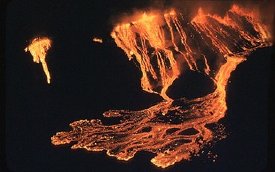Jun 21 2008
A University of Arkansas researcher and his colleagues have found differences in the iron isotope composition of basalts from a lava lake in Hawaii that point to new ways of studying the origins of the earth and other planets.
 This view from the present-day Kilauea Iki overlook shows lava flowing into what is now known as the Kilauea iki lava lake. Researchers determined that samples from the lake have differences in the iron isotope composition that point to new ways of studying the origins of the earth and other planets.
This view from the present-day Kilauea Iki overlook shows lava flowing into what is now known as the Kilauea iki lava lake. Researchers determined that samples from the lake have differences in the iron isotope composition that point to new ways of studying the origins of the earth and other planets.
Fang-Zhen Teng, assistant professor of geosciences and a member of the Arkansas Center for Space and Planetary Sciences, Nicholas Dauphas of the department of geophysical sciences and a member of the Enrico Fermi Institute at the University of Chicago, and Rosalind T. Helz of the U.S. Geological Survey report their findings in the June 20 issue of the journal Science.
The researchers examined iron isotopes in basalt samples from the Kilauea Iki lava lake on the main island of Hawaii. Isotopes have the same chemical properties but different weights, so some processes cause what looks like the same material to behave differently – often separating the two. Such separation can tell scientists something about how the material containing the isotopes formed.
However, until now scientists thought that such isotope fractionation only occurred at low temperatures and with elements of low molecular weight. Because of the heat and iron’s molecular weight, scientists thought that the process that formed basalts did not separate iron isotopes.
“There is a huge dispute on this topic,” Teng said. “Our research shows that there is clearly fractionation.”
Teng likens the change in iron isotopic composition in basalts to the baking of a cake: With a cake, you start out with certain ingredients, but the baking process changes the ingredients and their proportions within the cake. In the same way, the process that makes basalt magma through partial melting of the mantle peridotites, or rocks, changes the iron isotope compositions.
Past studies have examined basalts, but found little or no separation of iron isotopes. However, no one was studying the individual minerals found within a basaltic rock.
“We analyzed not only the whole rocks, but the separate minerals,” Teng said. The minerals examined showed a significant separation of iron isotopes, in contrast to the whole rocks. The researchers looked at olivine crystals, better known as peridot in the jewelry world, which formed and sank as the lava lake cooled.
“This research gives scientists a new tool to investigate the question of planetary differentiation,” said Dauphas. If basalts from the moon or Mars have similar iron isotope separation, it suggests that they formed through heat processes similar to those on Earth. However, if rocks from these planetary bodies do not have iron isotope separation, it suggests that they were formed in a different way.